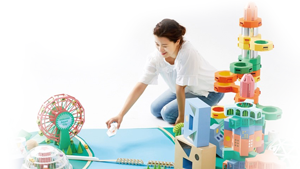The Passion of Paper Artist Lee Ji-hee

# Sales and Marketing
In this exclusive Dscoop interview, we talk with Lee Ji-hee, a remarkable paper artist who is passionately discovering the infinite possibilities of paper today.
September 18, 2023
The inflow of innovative digital gadgets continues to challenge old-era legacies like paper and printing. We're living in a "paper crisis" era, as some conventional paper and print categories give way to imperishable electronic images.
Throughout the last decade, Lee has made new discoveries in her paper art activities by combining various materials and techniques that can multiply the possibilities of the use of paper. In this Q&A, she introduces the unique world of her paper art that was built and cultivated by her original inspirations experiences.
Dscoop: Hi Lee, it's a great honor to meet you. Can you introduce yourself and your story as a paper artist?
Lee Ji-hee: Hi, it's nice to meet Dscoop community, too. I originally studied visual design in college and worked long as a designer in the field of industrial graphic design after graduating college. One day, when I was working in a design agency, I received a design request from a client in the export business for an annual report. Since their business was exportations, dealing with numbers and amounts, I came up with the idea of using paper materials to show how those numbers and amounts would increase or decrease. Based on the idea, I immediately started to create a sample paperwork of the whole concept and demonstrated it, and it was received by the client better than I had expected. I had been personally fond of making something out of paper and often tried it by myself, so I was used to working with paper already. But that was the first time I've used paper in earnest in my work. After the experience, I tried to use paper repeatedly whenever I had the opportunity to create design concepts in my work, and this gradually led me to change my career from a graphic designer to a paper artist. Finally, I started my career as an official and independent paper artist in 2013.
Dscoop: Can you introduce some representative pieces of your past art?
Lee: Among the various works and activities that I've made so far, what remained particularly special to me is "DOGcumentary: Thank you, Suzy," my first solo exhibition that was held in Seoul in 2017. Suzy was the name of the dog I lived with during my young days, and provided a main theme to the exhibition. I created various types of dogs out of paper, from a small size dog that looks like Suzy to a large size dog that is almost twice as tall as me. When you recreate living objects such as a dog with paper, the most important element is giving a depth to the paper model. In order to give this three-dimensional effect to the dog models, I enthusiastically learned new 3D design tools that I had never used before in other paper works. It was a great opportunity to learn not only those tools, but also to find out that my personal memories and experiences, which are stored in the depths of my heart, can be a great inspiration in order to create my unique works.


Making a stop-motion animation with Incheon International Airport's economic zone was a memorable project also. Luckily, I participated to the whole making process from planning to shooting, and had many chances to give my ideas and opinions directly to the project as the main artist. The collaboration with Pulmuone Kimchi Museum (now called Museum Kimchikan), which is operated by Pulmuone, a major Korean food maker, was a good experience to try something new. (The artwork appears below.) I created 10 different types of "Paper Kimchi DIY kit" as teaching material speacially designed for children's remote lessons. Since it was for children, I intentionally made it in assembly-kit format so children can make it easily without using glue. In addition, I enjoyed collaborating with "BESPOKE," a home appliance brand of Samsung. Thanks to the strong trust this client had in me, I could fully indulge in my work without any constraint and inconvenience.

Some of my works allowed me to be connected to foreign audience also. When I opened my "PAPER CAMERA" series to the public (shown below), I had the chance to show my works to overseas media such as "The Guardian" and "Colossal." The reason I decided to make camera paper models was very simple; it's because I've always been interested in cameras and mechanics. I especially liked old but classic camera brands such as LEICA, Rollei, Kodak and Plaubel Makina. I was very happy to receive a lot of attention from overseas media with this series.

Dscoop: The paper model of the Heidelberg letterpress machine is also very impressive. What was the trigger for this work?Lee: The art was firstly triggered by the "City Revitalization Project," which was sponsored by the metropolitan government of Seoul in 2019. This project was launched by the city with the aim of revitalizing several historical places in Seoul through collaborations with various artists. As one of the members, I chose the place of Euljiro, which has been historically the main symbol of the city's old printing industry. Since I wanted to make a paper model that can be associated with Euljiro and its old printing industry, I started to look for some ideas that could reflect that the two different media, paper and printing, have been connected tightly with each other throughout the past and present, and will evolve in the future to their own unique forms. With that in mind, I decided to recreate the Heidelberg letterpress machine which is a classic symbol that represents the printing method of the past out of modern-day papers. At the beginning I thought I could make it in about three months, but it took about half a year to complete. The work was more difficult than I expected because there were so many mechanical parts, so I had to study the machines closely by visiting Euljiro frequently.

Dscoop: What kind of printers do you use in your paper works? Do you also use Hp Indigo?
Lee: I'm using different types of printers depending on my work, and Indigo is one of them of course. I like the fact that Indigo gives more vivid and brilliant colors than normal offset printers do, so I prefer to use Indigo especially when I need to have samples of my work before final printing. Also, Indigo is indispensable for making "Paper DIY kits" that require folding creases. Among those many functions and benefits, what I find most convenient from Indigo is that all the systems of processes are totally interconnected. So it gives much great convenience to add additional corrections and adjustments in the middle of the printing job and allows the whole job to be done in a much shorter time. With Indigo, I can have the results that I desired in a short time and much easily, so it is a very satisfying work for an artist like me who is quite sensitive to colors and prints. Indigo is also great for printings with a variety of paper sizes, and it helps my work to be more efficient.
Dscoop: Please tell us about your plans for paper art works and activities in future.
Lee: In the field of commercial design, I have been able to work with various clients, and to try out new ideas and production methods with them luckily. On the other hand, in the area of artistic work activity, I still feel that it is difficult to call myself an "artist" since I am not active enough in creating what I want to express and deliver. Working in the commercial field is interesting, but I also crave to create my unique art works through my original ideas and inspirations, while I agree that the constant improvement of my skills and abilities is most critical whether it's in the field of commercials or fine art.

I think paper is a material that can be used indefinitely. In order to extend the expandability of paper, I think it is important to devise how, with what, and in which forms we can use paper. As an example, I'm studying how to add mechanical and kinetic parts to paper. Also, as a Korean artist, recently I am paying attention to traditional Korean manufacturing methods that can be applied to the world of paper art. That I learned Korean calligraphy 17 years ago was not just only for the better handwriting, but also for introducing the unique charm of the "Muk", the traditional Korean ink, into the paper art. Also, I have a strong desire to come into contact with foreign cultures and work since I have been mainly active in Korea until now. If I have the opportunity, I would like to promote various collaborations with various overseas fields.
Dscoop: Thank you very much for your time and perspective!
All photos in this article are copyrighted by Ji-hee Lee.
Sign in or Join the community
Innovating Print, Together

Create an account
Innovating Print, Together
